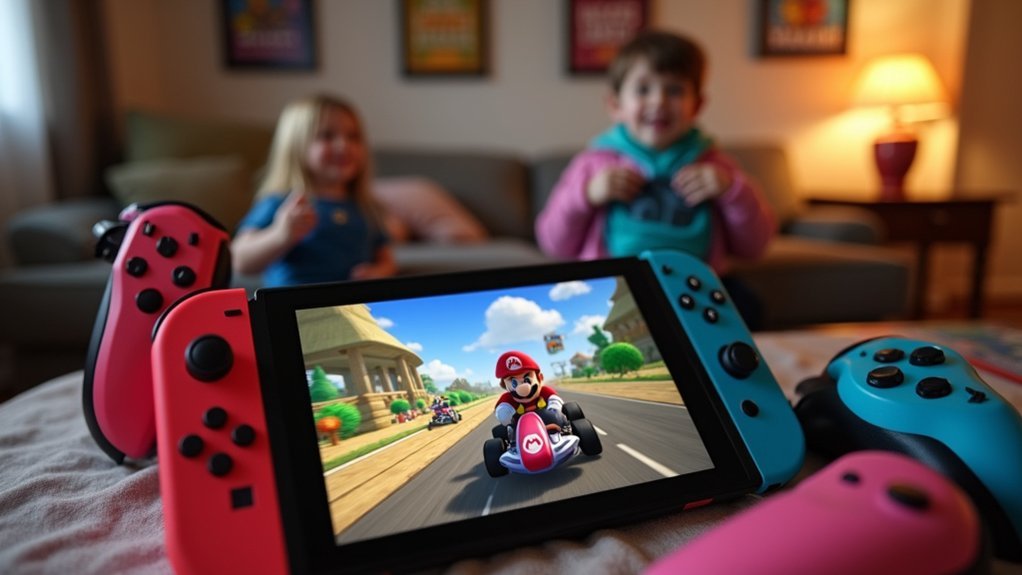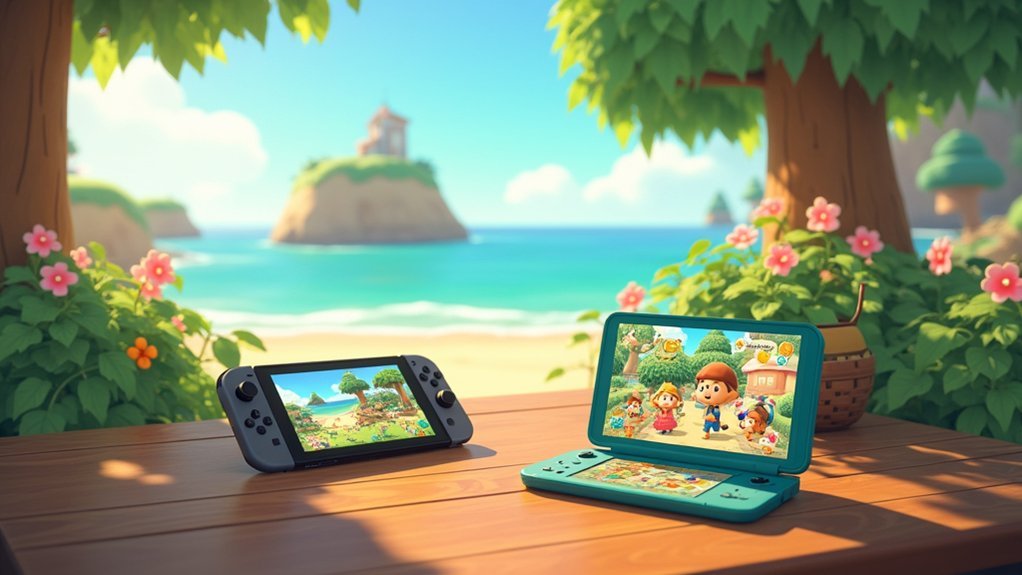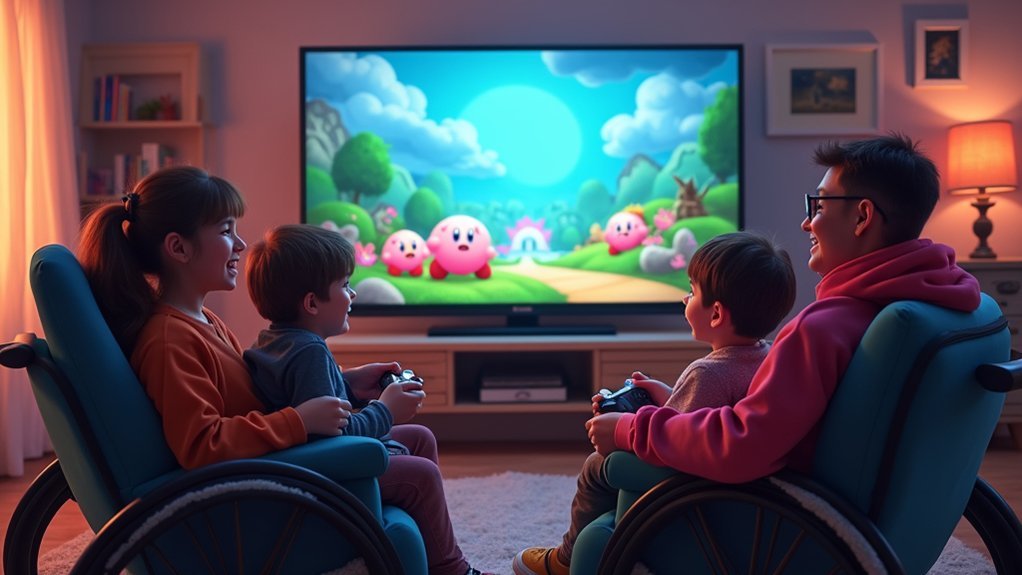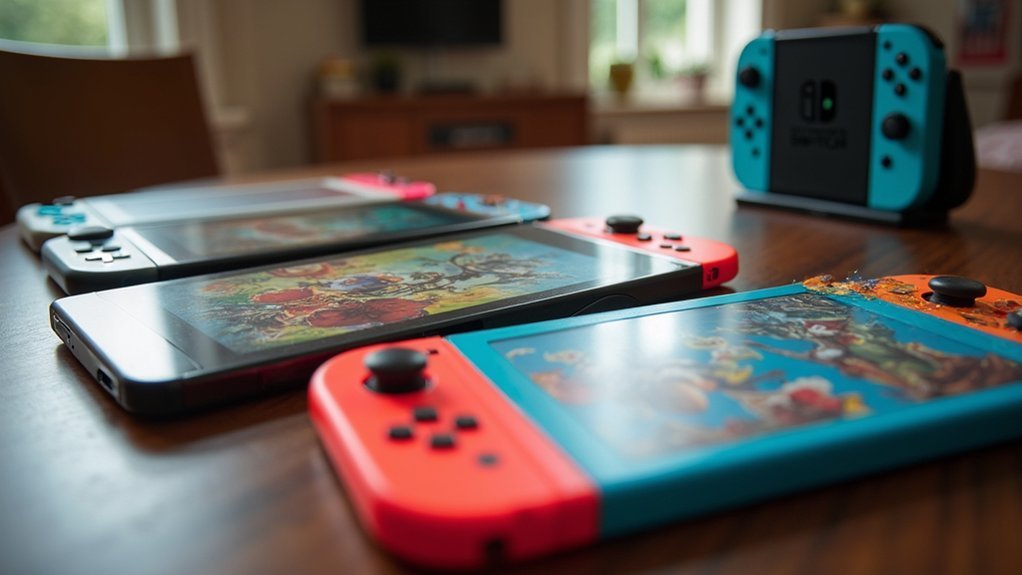The Nintendo Switch offers several accessible games for disabled gamers. Mario Kart 8 Deluxe includes Smart Steering and Auto-Acceleration features. Hades provides God Mode for reduced difficulty and visual accessibility options. Celeste’s Assist Mode offers customizable gameplay speed and stamina settings. Animal Crossing: New Horizons allows stress-free, adaptable play sessions. Luigi’s Mansion 3 features Co-Pilot Mode for shared control. These games demonstrate how thoughtful design choices can make gaming more inclusive for players with different abilities.
Mario Kart 8 Deluxe: Smart Steering For All Abilities

While many racing games can be challenging for players with disabilities, Mario Kart 8 Deluxe stands out with its innovative assist features.
Smart Steering automatically keeps your kart on the track, preventing accidental falls, while Auto Acceleration lets you focus solely on steering.
You’ll notice Smart Steering by the antenna on your kart that lights up when guiding you near edges. Both features can be toggled individually during kart selection using the L button or with +/- and Y buttons.
These accessibility options reduce the skill gap, making family play more enjoyable regardless of experience level. These features are a prime example of assist modes that enhance gameplay experiences for players of all skill levels.
Though they limit some advanced techniques like Ultra Mini-Turbos and shortcuts, they’ve transformed Mario Kart into one of the most inclusive racing games available, welcoming players of all abilities.
The Legend of Zelda: Breath of the Wild With Zelda Notes Support
The Legend of Zelda: Breath of the Wild presents a different accessibility landscape compared to Mario Kart 8’s inclusive design. While the game offers minimal accessibility features like camera sensitivity adjustments, it falls short with mandatory motion control puzzles that create barriers for disabled players. The game’s lack of customization makes it particularly challenging for players with limited mobility who cannot comfortably use the fixed bow and arrow controls.
The new Zelda Notes integration helps bridge some gaps by allowing you to navigate Hyrule and manage save data through the Nintendo Switch App. This feature, available with a Nintendo Switch Online + Expansion Pack membership, supports both Breath of the Wild and Tears of the Kingdom.
Unfortunately, you’ll still face challenges with non-remappable buttons and unavoidable motion controls in shrine puzzles. These issues can make game progression difficult or painful, despite the game’s popularity and influence in the Zelda series.
Animal Crossing: New Horizons’ Relaxed Pace Gaming

Animal Crossing: New Horizons offers you a invigoratingly stress-free experience with no rigid time constraints, perfect for managing disabilities that affect gaming stamina.
You’ll appreciate the game’s compatibility with single-handed play and adaptive controllers, though it lacks extensive control customization options.
Its leisurely pace lets you enjoy shorter play sessions on your own terms, making it an accessible choice when you need gaming that accommodates variable energy levels. The game features large font size which significantly improves readability for low-vision players, though it still lacks UI customization options like increased contrast.
Relaxed Time Constraints
Many disabled gamers struggle with rapid-fire gameplay and tight deadlines, which is why Animal Crossing: New Horizons offers a rejuvenating alternative. You won’t find pressing matters or urgent tasks on your island—everything unfolds at your chosen pace.
Unlike games that demand time optimization, Animal Crossing embraces slow progression. You can fish, decorate, or develop your island without time limits pressing down on you. This absence of urgency creates a mindful, stress-free experience where you’re free to engage or disengage without consequences. The game’s mechanics are specifically designed to promote a relaxed gaming experience that contrasts sharply with other fast-paced titles.
The game’s design particularly benefits those who find time-sensitive objectives challenging. You’ll appreciate how the long-term engagement model allows you to build a deep connection with your island community while accommodating physical limitations or cognitive processing needs.
Customizable Control Options
While time constraints represent just one accessibility barrier, control options form another key dimension of inclusive gaming. Animal Crossing: New Horizons does support one-handed play, which enhances accessibility for many players with motor limitations.
However, the game lacks extensive control customization within its settings. You won’t find options to remap buttons or create custom control schemes in the game’s interface. This limitation can create challenges for players who need specific button configurations to play comfortably.
Though the game offers some accessibility through large font sizes and helpful audio cues for actions like tool usage, these features don’t compensate for the absence of customizable controls. The game’s UI presents several issues for visually impaired players, particularly with white text that lacks contrasting backgrounds.
Adaptive controllers can provide workarounds, but these aren’t integrated features of the game itself. Future updates could greatly improve the experience by adding these much-needed customization options.
Flexible Play Sessions
Unlike fast-paced gaming experiences that demand constant attention, flexible play sessions represent one of Animal Crossing: New Horizons’ greatest accessibility strengths.
You can immerse yourself in island life at your own pace without time pressures or urgent deadlines. This drop-in/drop-out approach means you’ll never feel rushed—play for five minutes or five hours. The game adapts to your schedule, not the other way around.
For disabled gamers, this flexibility proves invaluable. You can take breaks when needed without penalties, enjoy measurable progress despite a relaxed pace, and engage with activities that suit your abilities. Many players establish consistent daily routines after playing for a few weeks, creating structure that works for their specific needs.
Many players find the experience therapeutic, reducing stress while fostering mindfulness. The absence of competitive urgency creates an inclusive environment where you can express creativity without pressure.
Kirby and the Forgotten Land’s Accessible Adventure Options

You’ll appreciate Kirby and the Forgotten Land’s Helper Mode, which simplifies gameplay mechanics for beginners or those with motor control challenges.
The game offers customizable contrast settings that enhance visibility for colorblind players, making obstacles and enemies easier to distinguish.
Motion sensitivity controls can be adjusted to your comfort level, allowing you to navigate Kirby’s 3D world without experiencing disorientation or physical strain.
The game’s predetermined camera angles and wide hitboxes for abilities ensure players don’t need to aim with perfect precision, making combat more accessible.
Beginner-Friendly Helper Mode
Kirby and the Forgotten Land shines brightly in its approach to accessibility through its beginner-friendly helper modes and intuitive design choices. The game embraces players of all skill levels with its simplified control scheme that displays clearly on screen.
You’ll find Mouthful Mode transformations like Stairs, Storage, and Water-Balloon uniquely accessible by pressing B, while holding Y lets you deactivate transformations when needed. Copy Abilities can be easily ejected using Y or – buttons, giving you flexible gameplay options.
The game builds on Kirby’s accessibility legacy with cooperative play possibilities, where a second player can join as a Helper to assist with combat and exploration. These Helpers feature separate health bars that can be replenished throughout gameplay, ensuring sustained support for the primary player.
This thoughtful design creates an inclusive experience where diverse abilities don’t limit enjoyment, making it an excellent choice for disabled gamers seeking engaging Switch adventures.
Colorblind Contrast Settings
You’ll find the fixed camera angles reduce visual confusion by limiting perspective changes.
Though color customization options are limited primarily to Kirby’s appearance, the game compensates with unique shapes and visual cues that don’t rely solely on color recognition.
Other Switch titles offer more robust accessibility features like dedicated colorblind modes and high contrast themes.
As developers continue engaging with the accessibility community, we’re likely to see improvements in future releases.
For now, *Kirby’s* vibrant environments and distinct visual design make it reasonably accessible despite its limited colorblind-specific settings. A free demo is available for players who want to test the game’s visual accessibility before purchasing.
Motion Sensitivity Controls
While Kirby and the Forgotten Land doesn’t feature extensive motion control options, it thoughtfully integrates tilt functionality only in the Sub-Game Tilt-and-Roll Kirby rather than making it mandatory for main gameplay. You can reset tilt controls for maximum accuracy during this mini-game.
The game’s accessibility shines through its forgiving design elements instead. You’ll appreciate the “fuzzy landing” feature that lets you jump again when close to the ground, and the camera-based hit detection that makes combat less frustrating. The game offers two difficulty modes to accommodate players of varying skill levels.
The gentle right-stick camera control helps ease the shift from 2D to 3D gameplay. These thoughtful design choices benefit players with motor or cognitive disabilities by reducing frustration and interruptions, creating an enjoyable experience without explicitly highlighting accessibility as a feature.
Pokémon Scarlet & Violet’s Customizable Controls
Despite its popularity among Nintendo Switch players, Pokémon Scarlet & Violet falls short in providing truly customizable controls for disabled gamers.
The game’s open-world design requires both analog sticks for camera movement, making one-handed play virtually impossible.
The dual-stick camera control requirement creates an insurmountable barrier for gamers who rely on one-handed play methods.
While the Switch offers limited button remapping capabilities, these aren’t sufficient for players with fine motor control issues. The game also lacks controller remapping options for accessibility, further limiting gameplay options for disabled individuals.
The absence of audiovisual cues for shiny Pokémon in the overworld creates additional barriers for visually impaired players.
Character customization options are also restrictive, with some features like skin tone locked at the beginning of your journey.
As the Pokémon franchise moves forward with DLCs and future titles, there’s hope that feedback from disabled players will lead to more accessible gaming experiences that meet industry standards.
Super Mario Odyssey’s Assist Mode Features
Super Mario Odyssey stands out as a beacon of accessibility on the Nintendo Switch through its thoughtfully designed Assist Mode. When activated, you’ll immediately benefit from doubled health (6 HP instead of 3) and the removal of death penalties, allowing you to explore without frustration.
The mode helps players of all abilities enjoy Mario’s adventure by providing:
- Objective markers that guide you through the main story path
- Time extensions for challenging timed sequences
- Automatic rescue when falling off cliffs, returning you to safe ground
- Reduced overall difficulty that maintains the game’s core mechanics
You can toggle Assist Mode on or off anytime during gameplay, making it perfect for players with disabilities, younger gamers, or anyone who prefers a less stressful experience while collecting Power Moons. The game also offers health regeneration when standing still, allowing players to recover without finding power-ups.
Nintendo Switch Sports’ Adaptable Motion Controls
Nintendo Switch Sports introduces a range of adaptable motion controls that provide both opportunities and challenges for disabled gamers.
You’ll find intuitive controls for eight different sports, with each allowing you to select your dominant hand during gameplay.
Unfortunately, the game lacks alternative control schemes and doesn’t support the Pro Controller, creating barriers if you have mobility impairments.
The absence of alternative controls and Pro Controller support significantly limits options for players with mobility challenges.
While the generous difficulty settings help make gameplay more accessible, the required physical movements may still exclude you if you have motor limitations. Sports like Tennis and Bowling can be played one-handed with restrictions, though Badminton and Volleyball require more complex movements.
Other Nintendo titles like Mario Kart 8 Deluxe offer more extensive accessibility features with smart steering and auto acceleration.
For Nintendo Switch Sports to truly accommodate disabled players, it would need customizable control options and alternative input methods beyond the current motion-only approach.
Hades’ God Mode and Visual Accessibility Settings
While Nintendo Switch Sports relies on physical motion, Hades offers accessibility through software-based solutions instead. The game’s standout feature is God Mode, which reduces damage taken by players and scales with repeated deaths, making the challenging roguelike more manageable without compromising core gameplay.
Visual accessibility receives attention through:
- Brighter on-screen cursors and UI elements for improved visibility
- Text display options that enhance readability for players with vision impairments
- Flexible difficulty adjustment that can be toggled at any point during gameplay
- Mono sound option in Hades 2 for players with single-ear hearing
You’ll appreciate that these features maintain the game’s integrity while removing barriers, letting you experience the full story regardless of physical or cognitive disabilities. The sequel introduces an autofire setting that significantly reduces the number of inputs required, making the game more approachable for players with mobility limitations.
However, some challenges remain, particularly with unpausable boss fights and limited colorblind support.
Celeste’s Assist Features for Physical Barriers
Renowned for addressing physical barriers that often limit gameplay, Celeste sets a gold standard with its extensive Assist Mode. You’ll find options to slow game speed by 10-50%, toggle infinite stamina for wall-clinging, and activate dash assist for precise movement control.
If your motor skills present challenges, you can enable invincibility or adjust air dashes to make navigation markedly easier. These customizable difficulty settings reduce timing pressure while preserving the game’s core experience.
What makes Celeste particularly remarkable is how these accessibility features were implemented thoughtfully rather than as afterthoughts. The developers actively revised the initial assist message to be more welcoming after community feedback about accessibility. The developers empowered players to define their own challenge level, expanding the game’s reach to those who might otherwise find it inaccessible.
The gaming community’s overwhelmingly positive response demonstrates how accessibility enhances rather than diminishes the gaming experience.
Luigi’s Mansion 3’s Co-Pilot Mode for Shared Play
Luigi’s Mansion 3 offers another excellent accessibility option through its co-op functionality, making ghost-hunting adventures accessible to more players with different abilities. Once you activate Gooigi early in the story, a second player can join the action, allowing for shared control and complementary gameplay.
- Single Joy-Con compatibility benefits players with hand dexterity issues, requiring less controller manipulation.
- Camera following Luigi helps guide less experienced players, reducing navigation challenges.
- Cooperative puzzle-solving distributes cognitive load, letting players contribute according to their strengths.
- Shared responsibility during gameplay creates a supportive environment for players who might struggle with certain game mechanics.
Players can easily toggle between solo and co-op play using the + Button to access the menu at any point during gameplay after acquiring Gooigi. This shared-play approach extends to the Scarescraper and ScreamPark modes, where up to 8 players can participate with flexible controller options, creating inclusive multiplayer experiences.
Frequently Asked Questions
Does Nintendo Offer Accessibility Certification for Third-Party Developers?
No, Nintendo doesn’t currently offer explicit accessibility certification for third-party developers. However, they’ve joined the Accessible Games Initiative, which will implement standardized accessibility tags to encourage better accessibility features in games.
Are There Switch Games With Colorblind-Specific Accessibility Options?
Yes, you’ll find colorblind options in several Switch games. Metroid Prime Remastered offers Nintendo’s first first-party colorblind mode, while Mortal Kombat 11, Fortnite, and Splatoon’s color lock feature also help colorblind players.
How Do I Find Games Compatible With External Adaptive Controllers?
You’ll find games compatible with external adaptive controllers by checking manufacturer websites, accessibility-focused forums, disability gaming communities, and specialized reviewers. Look for titles with simple controls or button remapping options for best compatibility.
Can Switch Games Be Played Using Voice Commands Only?
Currently, you can’t play Switch games using voice commands only. While the Switch 2 has voice chat features and text-to-speech functions, it doesn’t support controlling gameplay through voice commands alone.
Are There Games Designed Specifically for Single-Handed Play?
Yes, you’ll find several games designed for single-handed play, including “Yes, Your Grace,” point-and-click titles like “Unpacking,” and turn-based RPGs like “Fire Emblem.” Button remapping features also make more games accessible with one hand.
In Summary
You’re witnessing an important shift in gaming accessibility. With these ten Switch titles, Nintendo and third-party developers aren’t just accommodating disabilities—they’re celebrating inclusive design. Whether you’re using Smart Steering in Mario Kart or God Mode in Hades, you’ll find gaming experiences that adapt to your needs. The industry’s moving forward, ensuring everyone can enjoy these virtual worlds regardless of ability.





Leave a Reply